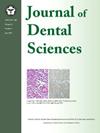自体脱矿物质牙本质基质对下第三磨牙手术后并发症和伤口愈合的影响:分口随机临床试验
IF 3.4
3区 医学
Q1 DENTISTRY, ORAL SURGERY & MEDICINE
引用次数: 0
摘要
本文章由计算机程序翻译,如有差异,请以英文原文为准。
The effect of autologous demineralized dentin matrix on postoperative complications and wound healing following lower third molar surgery: A split-mouth randomized clinical trial
Background/purpose
Autologous dentin materials are among the most promising bone substitutes for preventing osseous defects on the distal side of the lower second molar. This study aimed to investigate the effects of autologous demineralized dentin matrix on postoperative complications and wound healing after lower third molar surgery.
Materials and methods
Thirteen patients with bilateral symmetrical lower third molars participated in this split-mouth randomized clinical trial. After removal surgery, one socket of the lower third molar was grafted with dentin material (demineralized dentin matrix side), and a piece of collagen sponge was used for the tooth socket of the remaining side (control side). The upper third molar on the same lateral side was extracted immediately before lower third molar surgery and used to create a demineralized dentin matrix according to the manufacturer's protocol (KometaBio). After lower third molar surgery, pain, swelling, trismus, and Inflammatory Proliferative Remodeling Scale scores were used to evaluate postoperative complications and wound healing.
Results
Pain, swelling, and trismus of the demineralized dentin matrix and control sides were not significantly different at any assessment time (P > 0.05). The wound-healing scores of the demineralized dentin matrix side were better than those of the control side; however, the differences were only significant at 7th and 30th days (P < 0.05).
Conclusion
Grafting autologous demineralized dentin matrix into the tooth socket did not increase the postoperative complications after lower third molar surgery. However, wound healing on the graft side was comparatively better than that on the control side.
Clinicaltrials.gov identifier
NCT06073639, date 10 October, 2023. This is a retrospectively registered trial.
求助全文
通过发布文献求助,成功后即可免费获取论文全文。
去求助
来源期刊

Journal of Dental Sciences
医学-牙科与口腔外科
CiteScore
5.10
自引率
14.30%
发文量
348
审稿时长
6 days
期刊介绍:
he Journal of Dental Sciences (JDS), published quarterly, is the official and open access publication of the Association for Dental Sciences of the Republic of China (ADS-ROC). The precedent journal of the JDS is the Chinese Dental Journal (CDJ) which had already been covered by MEDLINE in 1988. As the CDJ continued to prove its importance in the region, the ADS-ROC decided to move to the international community by publishing an English journal. Hence, the birth of the JDS in 2006. The JDS is indexed in the SCI Expanded since 2008. It is also indexed in Scopus, and EMCare, ScienceDirect, SIIC Data Bases.
The topics covered by the JDS include all fields of basic and clinical dentistry. Some manuscripts focusing on the study of certain endemic diseases such as dental caries and periodontal diseases in particular regions of any country as well as oral pre-cancers, oral cancers, and oral submucous fibrosis related to betel nut chewing habit are also considered for publication. Besides, the JDS also publishes articles about the efficacy of a new treatment modality on oral verrucous hyperplasia or early oral squamous cell carcinoma.
 求助内容:
求助内容: 应助结果提醒方式:
应助结果提醒方式:


